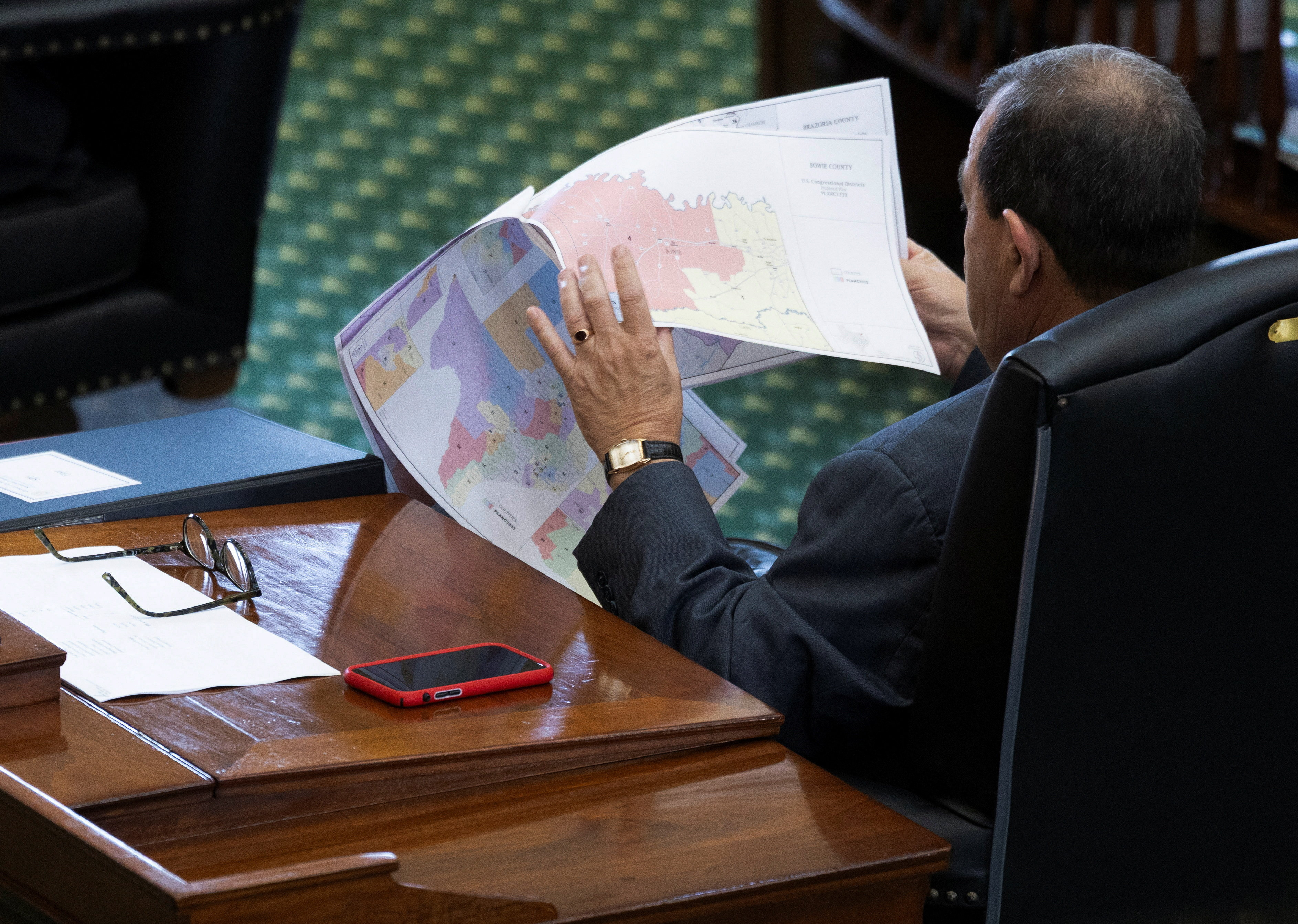Redistricting battles erupt ahead of midterm elections
Nov 4th California votes on Prop 50 Governor Newsom is in a brawl with Texas.
 Republican State Senator Pete Flores looks over redistricting maps as the Republicans attempt to pass a bill that would redraw the state's 38 congressional districts, at the Texas State Capitol in Austin, Texas, U.S. August 22, 2025. / REUTERS/Nuri Vallbona
Republican State Senator Pete Flores looks over redistricting maps as the Republicans attempt to pass a bill that would redraw the state's 38 congressional districts, at the Texas State Capitol in Austin, Texas, U.S. August 22, 2025. / REUTERS/Nuri Vallbona
The Texas State Senate has voted yes on the newly redrawn congressional district map with the aim of picking up five Republican seats during the midterm elections. Apparently a directive from President Donald Trump to find five new Republican Congressional seats led toTexas amending the Congressional district maps mid-decade. California shot back, stating its intent to roll out “trigger maps” with greater representation for Democrats, if any Republican state is successful in carving out new Congressional districts.
“California is about to come in a close second,” said Sam Wang, Director of the Electoral Innovation Lab at Princeton University at American Community Media(ACoM) briefing.
Redistricting normally occurs once a decade, following the US Census. Congressional district maps are redrawn to reflect changing demographics.This year, battle lines were drawn as Texas announced its intent to redraw its maps mid-decade.
Five other Republican states are considering similar actions.
Stop redistricting at the state level
The process of drawing the district boundaries (redistricting) is handled at the state and not the federal level. Each of the 50 states has its own laws and procedures for this.
Texas has no independent commission or state-level rules that constrain how redistricting is carried out. Instead, the Texas Legislature has full control over drawing political maps every 10 years after the census. The legislature can draw districts to favor their party.
Texas claims they are not freezing out Latino, Black, and Asian voters from districts that reflected their actual population growth. On the other hand they are avoiding illegality by refusing to draw coalition or additional majority-minority districts. They are seeking to comply with the law based on a letter that was sent to the Texas government by Attorney General Pam Bondi.
Every round of Texas redistricting since the 1970s has been challenged in court, and most cycles have resulted in findings that Texas discriminated against minority voters. The state failed to create new seats warranted by the growth of the minority communities, particularly the Latino community.
“ It is truly the Wild West,” said Wang. As a consequence, the only recourse available to Texas legislators on the Democratic side is to get their message out and increase awareness by walkouts, protests, or drawing national attention to influence public opinion.
“Gerrymandering is now attracting public attention in a way that it hasn't in decades,” said Wang.
Prop 50: the voters have to approve California’s redistricting
In California, redistricting reform is literally baked into the state constitution. Voters created and expanded the California Citizens Redistricting Commission, and the only way to change that system is through another statewide vote. That makes the process relatively insulated from partisan lawmakers.
What Governor Newsom is proposing is to change the Constitution temporarily to override that process until the next time the Commission meets.
That override is triggered by Texas's action.
California currently has 52 seats in the U.S. House of Representatives; 43 of these seats went to the Democrats, while nine went to the Republicans in the 2024 election. The five California Republicans targeted by the redistricting plan include Reps. Doug LaMalfa in District 1, Kevin Kiley in District 3, David Valadao in District 22, Ken Calvert in District 41 and Darrell Issa in District 48.
These districts are currently represented by Republicans and would be reconfigured to favor Democrats if voters approve Prop 50 on November 4th.
“Maps are the most fundamental building block of democracy in this country. If people see the lines are drawn in a way where they feel like their vote doesn't matter, then it's really hard to get people to turn out to vote,” said Thomas Saenz, President and General Counsel at MALDEF.
Redistricting could have significant implications in the 2026 midterm elections. Having more districts across the US could tip the balance of power in the US House of Representatives. Both Republicans and Democrats now want to win that advantage for themselves.
California and Texas are the two most populous US states with together having more than 70 million Americans, and a combined 80+ seats in the U.S. House of Representatives. That’s roughly 1 in 6 House members nationwide. Control over these states’ maps can shift the national balance of power for a decade.
ADVERTISEMENT
ADVERTISEMENT
E Paper
Video



 Ritu Marwah
Ritu Marwah 












Comments
Start the conversation
Become a member of New India Abroad to start commenting.
Sign Up Now
Already have an account? Login